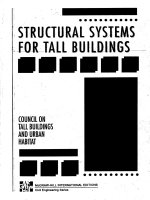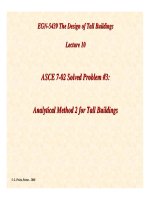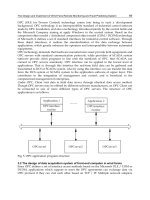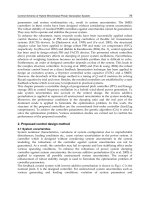lecture10 ASCE 7 wind tall buildings
Bạn đang xem bản rút gọn của tài liệu. Xem và tải ngay bản đầy đủ của tài liệu tại đây (4.16 MB, 21 trang )
© L. Prieto-Portar - 2008
EGN
EGN
-
-
5439 The Design of Tall Buildings
5439 The Design of Tall Buildings
Lecture 10
Lecture 10
ASCE 7
ASCE 7
-
-
02 Solved Problem #3:
02 Solved Problem #3:
Analytical Method 2 for Tall Buildings
Analytical Method 2 for Tall Buildings
The building for this third example is a 14-story office building in Tampa. It is 100 feet wide and
200 feet long and 160 feet tall, including a 3 foot parapet. The structure is a reinforced concrete
rigid frame, with each floor and the roof providing a diaphragm reaction to lateral loads. Each
floor is 11 feet high, and is clad with two glazing panels 5’ –6” high and 5 feet wide (aluminum
mullions are spaced 5 feet on-center). The glazing is resistant to wind-borne debris impact.
For simplicity, the office building is assumed to be in an Exposure B. It is not an
essential facility, nor will it be occupied by 300 people in a single area at one time.
Therefore, it is a Category II (see Table 1-1 on the next slide).Example #3 will use the same location in downtown Tampa as in Examples #1 and #2.
For this Example #3 site, use V = 120 mph.
( ) ( )
( )
( )( )( ) ( )
( )( )
2
2
0 00256 0 00256 1 0 0 85 120 1
35
0 31
1
3
157 31 3 1 12
= −
= = =
= = = =
z p pi
z
z z zt d z z
z h
The design pressure p is,
p q GC GC
where the velocity pressure q is,
q . K K K V I . K . . . . K
Using ASCE-7-02, Table 6-3,
at z feet
., q q . . psf
The building has a ratio of h / least width = 160 ft / 100 ft = 1.6 < 4 which means that
it can be classified as a rigid structure. The gust G is given by Equation 6-4,
( )
(
)
( )
( )
( )( )( )
( )( )
( )
min
1 1.7
1 1.7 3.4 0.25 0.83
0.925 0.925 0.83
1 1.7
1 1.7 3.4 0.25
3.4 ( 6.5.8.1)
0.6 157 94.2 ( 6.5.8.1)
30 ( 6 2)
0.30 ( 6 2)
33
Q z
v z
Q v
z
g I Q
G
g I
where g g Section
z ft Section
z z ft Table
c Table
I c
z
+
+
= = =
+
+
= =
= =
= = −
= −
=
( )
( )
1 1
6 6
1 1
3 3
0.63 0.63
33
0.30 0.25 ( 6 5)
94.2
94.2
0.30 454 ( 6 7)
33 33
1 1
0.83
100 157
1 0.63
1 0.63
454
z
z
Equation
z
L c ft Equation
Q
B h
L
= = −
= = = −
= = =
+
+
+
+
The External Pressure Coefficients C
p
for walls.
The external pressure coefficients for the wall surfaces are taken from Table 6-6:
Therefore, the wall C
p
is,
The Roof Pressure Coefficients Cp for winds normal to the 200-ft walls.
For the first value and h/L = 157/100 ~ 1.6 > 1.0 and < 10º the roof pressure
coefficients are also given by Figure 6-6,
C
p
for wind normal to the
200 ft wall.
C
C
p
p
for wind normal to the 100 ft wall.
for wind normal to the 100 ft wall.
The second value of C
p
= -0.18 is a small value and is not used in this example.
The roof C
p
with wind normal to the 100 ft face, h/L = 157/200 ~ 0.8. Notice that
interpolation is needed in Figure 6-6.
The external pressure at the roof at a distance from 0 to h/2 = 157 ft / 2 = 79 ft from
the edge with the wind normal to the 200 ft face.
The external pressure at the roof at a distance from 79 ft to 100 ft from the edge with
the wind normal to the 200 ft face.
( )( )( )
35 1 0 83 1 04 30 3= = − = −
z p
The external design pressure p is,
p q GC . psf . . . psf
( )( )( )
35 1 0 83 0 70 20 4= = − = −
z p
The external design pressure p is,
p q GC . psf . . . psf
Comparison of pressures between the two orthogonal faces.
How do the pressures change if some of the windows are breached?
Internal pressure coefficients GC
pi
.
If the windows are breached by debris, the building becomes a “partially enclosed”
building. In that case, the internal pressure coefficient becomes,
The negative internal pressure p
i
will be evaluated using q
i
= q
h
= 35.1 psf,
Negative internal pressure = q
h
(GC
pi
) = (35.1 psf)(-0.55) = -19.3 psf
The positive pressure is found at the height z = 90 ft and q
z
is found through inter-
polation,
Positive internal pressure = (30.0 psf)(+0.55) = 16.5 psf
(
)
z p i pi
p q GC q GC
= −
0.55
pi
GC
= ±
Wind Force on the Roof Parapet.
The pressure on the parapet with MWFRS p
p
is,
Since the parapet is 3 feet high, the force on the parapet in the MWFRS case is as
follows,
These forces are shown in the figures of slides #14 and #16.
(
)
(
)
( )( )
35.4 1.8
35.4 1.1
p p pn
p p pn
p q GC psf for the windward parapet
p q GC psf for the leeward parapet
= =
= = −
(
)
(
)
(
)
( )( )( )
35.4 1.8 3 191.2
35.4 1.1 3 116.8
windward p pn wall
leeward p pn wall
F q GC h psf feet plf
F q GC h psf feet plf
= = =
= = − = −
References.
References.
1. American Society of Civil Engineers, Publication ASCE 7-02, “Minimum Design
Loads for Buildings and Other Structures”, Washington DC, 2002;
2. W. C. Bracken PE, “Wind Load Design”, Florida Engineering Society, Tallahassee,
2007;
3. K.C. Mehta, J.M Delahey, “Guide to the Use of the Wind Load Provisions of ASCE
7-02” ASCE Press, Washington DC, 2003.
Arizona cactus flower









